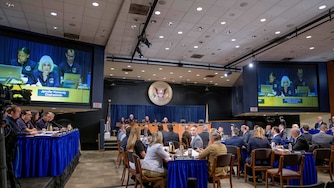Yes, Baltimore County really does recycle.
No, residents and businesses are not really throwing it all away.
And yes, county officials know why you might think that.
The Cockeysville recycling facility took a credibility hit in 2020 when government officials sheepishly admitted that although they were collecting glass, they couldn’t recycle it. That got residents wondering about everything else, and whether it was worth their time to separate out paper, plastic and metal and put it out in recycle bins.
Yes, yes, and yes, said Nick Rodricks, bureau chief of solid waste for the Baltimore County Department of Public Works and Transportation. Give us your plastic, your paper, your cardboard, your aluminum cans, and, yes, your glass, which the county resumed recycling in 2022 under a long-term contract, he said.
“People always ask me, ‘Does stuff really get recycled?’ And I tell them, if it ends up here, at least 75% of it does,” Rodricks said.

What doesn’t, he said, are items too contaminated to clean and reuse. At the county’s Material Recycling Facility on Warren Road in Cockeysville, known as “the Merf,” a team of about 60 work in shifts to clean, sort and bundle plastic and cardboard for resale.
It takes four minutes of sorting and treatment for one aluminum soda can or Tide laundry jug to land in one of the bundles, which workers meticulously clean before brokers from Georgia Pacific and other companies come in to inspect and purchase. Within a few weeks, the bundles will become new boxes, new jugs, new milk bottles — sparing valuable landfill space.
“We take a lot of pride in these,” said Bill Olfson, a public works spokesperson who leads tours of the county’s facility. “Our material has always been very good, and customers frequently tell us that.”
The $23 million single-stream recycling facility opened in 2013, and while it does not quite pay for its own operations with profits from the sale of paper and glass, some years it comes close. Profits and losses depend on Wall Street, which sets prices for the commodities.
Americans produce about 4.5 pounds of trash per person per day, according to the U.S. Department of Energy. In 2017, that equaled 267 million tons of municipal solid waste; about half of that goes to landfills.
Maryland landfills have an average of 14 years of space left, and no community really wants one. So Olfson and Rodricks do all they can to keep every possible milk carton and aluminum can from becoming waste. Each one, they argue, should become another version, recirculated ad infinitum. There’s no limit on the number of times a can of Sprite can be a can of Sprite.



When Baltimore County moved to single-stream recycling instead of asking residents to sort products, more residents began putting out their bins. Now, Olfson wants apartment buildings in the recycling fold.
So far, he said, he’s recruited 10,000 new building units. It took some creativity, he said, like adding more dumpsters for paper, plastic, glass and cardboard close to the units. It also took a campaign to remind residents, and buy-in from complex owners. But once residents understood how little was required, Olfson said, they embraced it.
The county facility recycles 240 tons of plastic each month, according to Richard Keller. Soda bottles make up more than half; the rest are laundry and cleaning containers.
Once the county eliminated single-use plastic bags at stores, Keller said, the center reported a huge decline in wasted plastic and wasted time. The bags, he said, used to become tangled in the rest of the useful plastic and gummed up the conveyor belt system.
Not having them, Olfson said, is like “night and day.”


Some challenges remain with recycling and trash for the county, whose $80 million waste management budget mostly goes to collection from the homes and apartments of its nearly 850,000 residents. The biggest one is lithium batteries, which have caused fires in several state landfills.
Lithium batteries lurk in cameras, tablets, phones, laptops, and other electronics. Simply throwing them in the trash with household waste can promote overheating or breakage.
The recycling center has a designated area for electronic recycling, but a lot of people don’t know that.
Rodricks is serving on a state panel with Maryland Recycling Network President Kitty McIlroy to draft a bill to establish a fund so all recycling centers include a place to drop off batteries.
In 2025, Maryland passed legislation that makes producers of paper and packaging companies responsible for the costs of reusing materials. McIlroy said Maryland became the seventh state to approve legislation asking those manufacturers to compensate states for their products in the environment and the costs of collection.
Over the years, the county’s recycling facility sometimes struggled to find workers for what is one of the nation’s most dangerous jobs. For a time, the county brought in incarcerated workers from the Baltimore County Detention Center, but stopped when one inmate filed a lawsuit over fair wages. That ongoing lawsuit already has cost the county more than $4 million; the program was discontinued and uses mostly contractors.
The county welcomes recycling skeptics to tour the facility; if they are at least 10 years old and wear a hard hat and vest. Beware: It smells, but interesting birds swoop overhead — grackles, crows, and occasionally eagles — and the tour guides are almost evangelical.
“The easier we make it, the more people will do it,” Olfson said of recycling. “People say, ‘I’m confused.’ So we say, ‘Let Baltimore County help you sort it out.’”




Comments
Welcome to The Banner's subscriber-only commenting community. Please review our community guidelines.